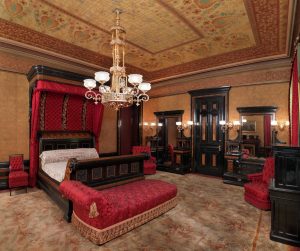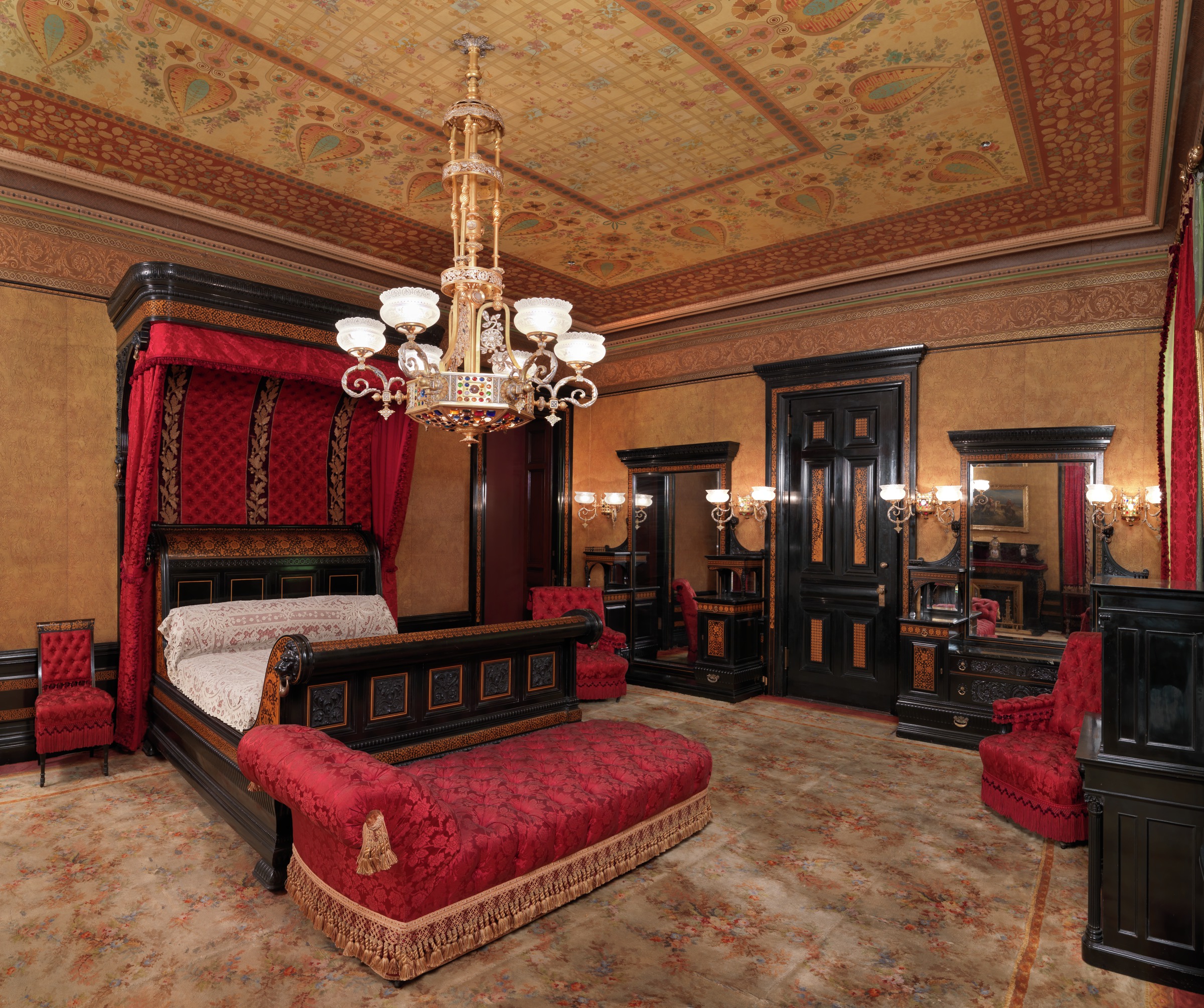
Art in Depth: The Worsham Rockefeller Bedroom
Explore VMFA's only period interior and learn more about its making, history, and owners.
Overview
The Worsham Rockefeller Bedroom was originally housed in the New York home of Arabella Worsham Huntington at 4 West Fifty-fourth Street. Richmond native Worsham Huntington moved into the mid-1860s built Italianate style home in 1880 after three years of renovations to the property. She lived there until 1884 when the property was sold to American oil magnate, John D. Rockefeller. The room showcases the Aesthetic Movement style of furnishing that was fashionable during this time period. The approximately twenty-five by twenty-eight feet room was originally decorated with stamped rose-colored wallpaper, ornate carpeting, multicolored glass and brass light fixtures, and a suite of ebonized inlaid mahogany furniture. Upon the death of Rockefeller in 1937, the Bedroom was left to the Museum of the City of New York. In 2008, the Museum of the City of New York kindly transferred the room to the Virginia Museum of Fine Arts as it is located in the hometown of Arabella Worsham Huntington. The Worsham Rockefeller Bedroom is the first and only period room at the VMFA.

Worsham Rockefeller Bedroom
1881-82, revised ca. 1937
Decoration attributed to George A. Schastey and Company (American, active 1873-97) or Pottier and Stymus Manufacturing Company (American, active 1859-1919)
Furnishings Attributed to George A. Schastey and Company and Sypher and Company (American, active 1869-1908)
Ebonized and inlaid mahogany, textiles, metal, glass, ceramic
Gift of the Museum of the City of New York, 2008.213
Arabella Worsham Huntington (1850-1924)

Arabella Duval Huntington, c. 1870. Public Domain Image.
Image found here.
Arabella Worsham Huntington was an art collector, philanthropist, and socialite who started life in modest circumstances and rose to become one of the richest women in America. Born Catharine “Bell” Duval Yarrington in Richmond, VA, during the Summer of 1850. She was the daughter of Richard Milton Yarrington, a carpenter-machinist, and his wife, Catherine, who operated their home as a boarding house. Right before the outbreak of the Civil War, Arabella’s father died and she and her mother were left to keep operating their residential hotel in war-torn Richmond. John Archer Worsham was a prominent business owner in Richmond and worked only six blocks away from Arabella’s home where the pair were thought to have initially met sometime around 1860. Arabella and John Archer Worsham wed in 1869 after both of their families had fled Richmond to New York in order to escape the Union troops occupying Richmond. In the census of 1870 the pair were recorded as living under the same roof with their three-month old son. The marriage only lasted a year as some stories suggest that Worsham died and others claim that he went back to Richmond to be with his first wife. Arabella would later in 1871 move in with Collis P. Huntington, an industrialist and Railroad investor, with whom she had established a romantic relationship. Huntington and Arabella did not officially wed until 1884 after Huntington’s first wife died.
This relationship is the mark of Arabella’s rise in economic status. The couple was known for their shared love of collecting art and traveling. They travelled together numerous times to Europe between 1880 and 1890 where they acquired many works of art. When Huntington died in 1900, Arabella was left as one of the richest women in America. Arabella mourned this loss deeply and did charitable acts in Huntington’s honor such as establishing the Collis P. Huntington library in San Francisco, CA. Thirteen years later after the death of Collis Huntington, Arabella married Huntington’s nephew, Henry E. Huntington, whom she helped create the collection that would be showcased at the newly assembled Huntington Library in San Marino, CA. This collection was truly one of the highlights of Arabella’s later years. Arabella died in 1924 and is buried at the Mausoleum at the Huntington Library.
John D. Rockefeller (1839-1937)
John D. Rockefeller was an American businessman and philanthropist who was one of the wealthiest Americans who ever lived. Rockefeller, similar to Worsham Huntington, was born into modest circumstances and grew to become one of the richest men in the country. He was born on July 8, 1839 in Southern New York state to William Avery Rockefeller, a local wellness purveyor, and Eliza Davidson Rockefeller. Rockefeller’s mother was a very pious and religious woman and instilled in her son the importance of hard work, saving money, and giving back charities within the community. By the age of 20, Rockefeller had started his own profitable business selling goods including grain, hay, lumber, and meat and his business savviness only grew from there. Rockefeller watched the rise of the railroad age and he conjectured that fuel was going to be a precious commodity for the railroad system to be successful. This is how he decided on his next business venture in oil refining. In 1866, Rockefeller established Standard Oil Works and this is where he would amass his great fortune. Rockefeller died in 1937 leaving his estate worth over $26 million dollars split between various charities and his heirs.

John D. Rockefeller, 1885. Public Domain Image.
Image found here.
Gilded Age
The Gilded Age is the term used to describe the time period between 1870 and 1900 when there was rapid economic growth in the United States. American writers Mark Twain and Charles Dudley Warner coined the phrase “the Gilded Age” in their 1873 novel of the same name. During this time, the US became the international leading producer of food, coal, oil, lumber, and steel. This period is also marked by the vast number of people who immigrated to the United States greatly changing what the American experience looked like. There were large gaps in income inequality so this time really divided the American public into two distinct classes: the working class and the upper class. This was an era of great turmoil, but also great transformation in America.
Aesthetic Movement
The Aesthetic Movement is the International art style that flourished in the United States during the Gilded Age. The movement began in Great Britain based on the philosophies of John Ruskin and William Morris arguing the notion that a “beautiful” environment promoted moral and social reform. Interior spaces were transformed into the German concept of “Gesamtkunstwerk” or roughly in English total works of art with each piece in a room being hand selected for its artistic merit to create a cohesive beautiful environment. Aestheticism emphasizes international influences such as Japanese, Greek, Egyptian, Islamic, and Chinese art and design. Large international exhibitions helped to expose the general public to Aesthetic Movement furnishings especially during the time period between 1871 and 1878 when there were exhibitions held in London, Vienna, Paris and Philadelphia. Artists at these exhibitions promoted the benefits of artistic interiors and the benefits that this kind of living could have for the consumer.
Bedroom Highlights

The Bedstead
For this commission, Collis Huntington employed a few different high-end companies to produce the furniture seen in the Worsham Rockefeller bedroom. These firms included George A. Schastey, Herter Brothers, Pottier and Stymus, and Sypher and Company. It is thought that any or all of these esteemed craftsmen worked on this project but there is complicated documentary evidence to confirm these details. The design for this particular bed was inspired by a bed that belonged to Princess Mathilde Bonaparte Demidoff, niece of Napoleon. The bedroom furniture was produced as an en suite set characterized by the use of ebonized mahogany, intricate marquetry, and red damask tufting. The patterning seen in the inlaid cornice, headboard, and side panels of the bed show an elaborate vine pattern that recalls the patterns “Indian and Burmese” and “Moorish” from Owen Jone’s The Grammar of Ornament (1856). The overhanging cornice on the bed is reminiscent of French Second-Empire designs and is upholstered in French-made silk textiles that provided a sense of security and warmth.
Secretaire
The ebonized and inlaid secretaire can be seen in the Worsham Rockefeller bedroom across from the bedstead against the wall. The inlay seen on this work is reminiscent of marquetry that is often incorporated in the works of the Herter Brothers. Gustave and Christian Herter were German immigrants who started one of the leading cabinetry companies of the late 19th Century. Herter Brothers were known for implementing entire interiors including furniture, wall decorations, flooring, and textiles to create luxurious rooms that the New York elite coveted for their homes. Often seen in Aesthetic Movement designs by the Herter Brothers, they incorporated ebonized wood with golden satinwood marquetry to showcase clear Eastern influences. This was a popular design choice because the Anglo-Japanese style was very fashionable at this time.


Side Chair
This ebonized mahogany and red silk damask upholstered chair can be seen in the Worsham Rockefeller bedroom with a small writing table to the left of the fireplace. The chair is attributed to cabinetmaker George A. Schastey. Works produced by Schastey at the end of the 19th Century were known for their exceptional quality and beautiful detailing. Schastey, a German immigrant, worked for various firms such as Pottier and Stymus, Herter Brothers, and Conrad Boller before branching out and starting his own furniture making workshop in 1873. He worked solely on commission-based projects and produced furnishing for many prominent business magnates during this last decade of the 19th Century. Arabella Worsham liked his work immensely and had him furnish three additional homes of hers after he worked on pieces for her 4 West Fifty-fourth Street home.
Chandelier
The Worsham Rockefeller monumental chandelier can be found centrally hanging from the ceiling in the bedroom. The base of the chandelier is made of brass and it is accented with opalescent and multicolored glass stones. The room showcases additional matching light pieces including four matching two-arm wall lights and a one armed sconce. These works incorporate stylistic influences from Renaissance, Gothic, and Eastern motifs. The large scale size of the chandelier makes it a prominent focal point for the room.

Sources
Fitzgerald, Oscar P. Four Centuries of American Furniture. Radnor, PA: Wallace-Homestead Book, 1995.
Gallagher, Moira. “George A. Schastey and Company, Gilded Age Cabinetmakers.” Chipstone, 2016. http://www.chipstone.org/issue.php/41/American-Furniture-2016.
Lewis, Arnold, James Turner, and Steven McQuillin. The Opulent Interiors of the Gilded Age All 203 Photographs from “Artistic Houses”, with New Text. Mineola, NY: Dover Publications, Inc., 1987.
“Library Table, 1879-82, Herter Brothers.” metmuseum.org. Accessed January 10, 2021. https://www.metmuseum.org/art/collection/search/4785.
Mollno, Linda. “Arabella Huntington: A Woman of Mystery.” San Marino Tribune, December 24, 2020. https://sanmarinotribune.com/10372-2/.
O’Leary, Elizabeth L. American Art at the Virginia Museum of Fine Arts. Richmond, VA: Virginia Museum of Fine Arts, 2010.
Poole, Keith. “Biography: John D. Rockefeller, Senior.” PBS. Public Broadcasting Service, 2007. https://www.pbs.org/wgbh/americanexperience/features/rockefellers-john/.
Riley Noël, and Patricia Bayer. The Elements of Design: a Practical Encyclopedia of the Decorative Arts from the Renaissance to the Present. New York, NY: Free Press, 2003.
“Secretary from the Jay Gould House, New York City, 1882, Herter Brothers.” metmuseum.org. Accessed January 10, 2021. https://www.metmuseum.org/art/collection/search/7366.
Virginia Museum of Fine Arts: Visitor Guide. New York, NY: Scala Arts & Heritage, 2016.




